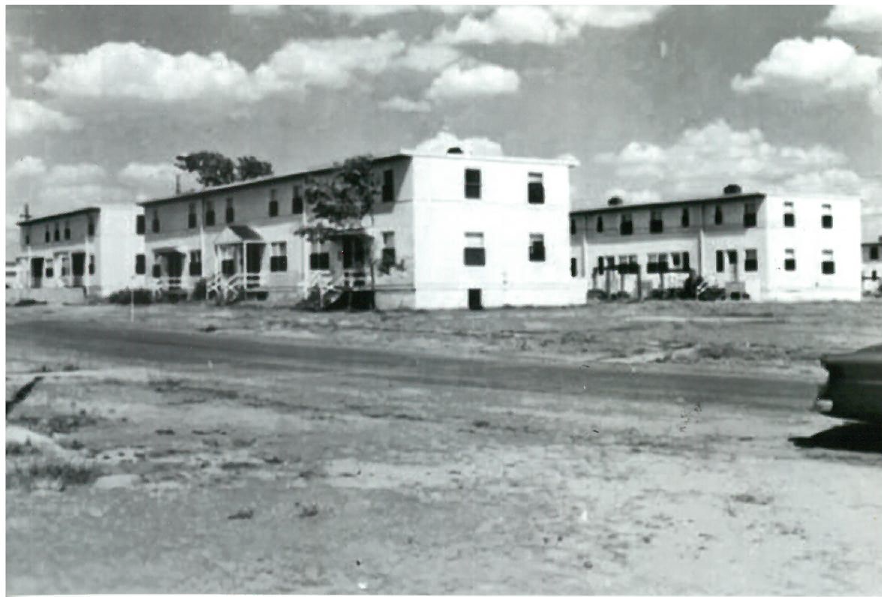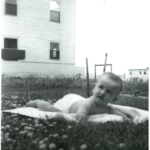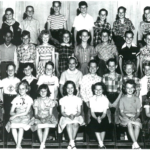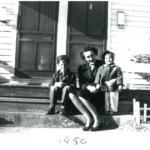Editor’s note: This is the longer version of Donald Willis’ article on the World War II era Beechwood housing project that appeared in our September issue.
I have enjoyed reading the articles in The Active Age from the “Wichita Old Neighborhood Project” overseen by Patrick O’Connor. I would like to tell of my old neighborhood, which is now totally gone and I doubt there are many left who know it ever existed. This saddens me because I thought, and still think, that it was a great place for kids to grow up.
Beechwood, Planeview and Hilltop Manor were rapidly built in 1942-1943 to house the aircraft workers who inundated Wichita during World War II. These housing areas were formally dedicated on April 25, 1943 by the Federal Public Housing Authority which was charged with their construction and management. Most of the workers at Beechwood were employed at the Beech Aircraft Company which was close enough for them to walk or bike to work.
The homes in Beechwood looked like Army barracks, two story buildings some of which had four families living in them with two bedrooms, and some with three families, with larger three- bedroom places on each end with a smaller one bed-room home between them. There were originally 400 of these units and the population of Beechwood was about 2,500. The buildings were set up around a circular street with several cul-de-sacs on the outer edge with 3 to 4 of the buildings in each; and there were also a few units facing north bound on Douglas Street which was the northern edge of the community.
Beechwood was built on a 40 acre tract of land just south of Douglas and across the street from the wealthier Forest Hills addition. Eastborough was about two miles west. At the time, this was the only area occupied in the whole section that was bounded by Douglas Street on the north; Webb Road on the east; Rock Road on the west, and Kellogg or Highway 54 on the south. The area that is now the Bonnie Brae addition and home to the Wichita Independent School was a 9-hole sand green golf course belonging to the Beech Employees Club.
The average rent was a reasonable $32/month, which seems cheap today, but I doubt that the hourly pay for most Beech employees was even $1.00 per hour. The homes had ice boxes supplied by delivery men on a regular route, and each home had a coal burning furnace with coal supplied by the FPHA. There were big cinder block bins scattered across the development which were filled with coal by the government and each home had an attached coal bin. It was up to each homeowner to move coal from the big bins to their own bin. Kids were usually assigned this task, and it was possible to make a little money doing it for others, but I now wonder if the proceeds covered the cost of the laundry and bathing required. Cleaning out the ashes and cinders from the furnace was another job usually given to boys in each family.
It is difficult today to convey how winning World War II colored everything in Beechwood, and in the country as a whole of course. Even though I was only 3 years old, I still remember the celebration and parade that happened on V-J Day, although I probably didn’t know what we were celebrating.
I did not remember until reading Craig Miner’s, “Wichita, the Magic City”, that 214 of the 400 Beechwood housing units were torn down soon after the end of the war. They were built as temporary housing, and the city of Wichita wanted to tear them all down, but there was not enough housing in the town to accomplish this. I should also give credit to an article from Kansas History entitled, “Want to Build a Miracle City” by Julie Courtwright for much of the preceding historical information.
A tornado hit Beechwood in 1948 and resulted in the demolition of about three to five more of the buildings. I slept through it. The empty lots became baseball fields or playgrounds.
The people who moved to Beechwood went there because of the economic opportunity afforded by the war effort. My Father was a fireman in Pittsburg, Kansas and took the same job at higher pay at Beech Aircraft Company, leaving my mother and myself and older sister behind until he could find housing for us. Others came from little towns and farms all over, a great many from Oklahoma. Beechwood had several Indian families from Oklahoma; the Tigers, Squirrels, Moons, Bobbs and Guydelkens are names I recall. The Tiger family occupied the other half of our unit in Beechwood. They had 6 or 7 kids and we eventually had 6, so we got along well. The boys in the Tiger family were pretty good athletes, probably inherited from their father. Mr. Tiger once showed me a scrapbook that showed he had pitched a no-hitter in the National Baseball Congress tournament at Lawrence Stadium in Wichita before the war.
The great number of children living in Beechwood made it a magical place if you were one of the kids. There was always something to do or play limited only by imagination of the kids involved. There was very little involvement from grown-ups among us, and we could almost always round up enough kids to get up a baseball game of “work-up”, where you could keep batting until put out, and then had to start over in right field.
Beechwood had a large building facing north on Douglas Street which housed the grocery store, run by George and Frank Farha; a lunch counter/drug store (with several pinball machines) operated by Eddie Jabara; a barber shop but I cannot recall the name of the barber; and a tavern or “beer joint” at the east end of the building. I was forbidden to enter the tavern and do not know who operated it.
On the west side of the circular main street was located the office and maintenance department of the FPHA. It took several maintenance men to keep all the places in repair. The south end of this connected building housed Beechwood Grade School, which was the center of almost all activity in the community. A gymnasium separated the offices and the school. The old gym served not only as a basketball/recreation court, but also was utilized for school programs, plays, musical concerts, graduations, and as a church on Sundays. It also became a theater during the winter for one night a week.
Mr. George Woodruff every week lined up a cartoon, ongoing serial and/or movie short, and then a feature film, usually a “B” western, for the entertainment of the many kids in Beechwood. I think admission was a dime, and while Mr. Woodruff ran the projector, his son, Larry, and sometimes myself sold popcorn and candy at very nominal prices. I am sure it was more of a community service than a money maker. During the warm summer months, the movies were moved to the outside and projected on the windowless white west wall of the gym where it was somewhat protected from the wind. The number of kids gathered here was tremendous. Remember we did not yet have television.
In recent years Larry Woodruff and I have reconnected and have enjoyed reminiscing about those old days.
Beechwood Grade School was part of the Sedgwick County school system and went from kindergarten to the 8thgrade. I think that Beechwood had very good teachers considering the relatively poor background of many of the students. Some that stand out in my memory were Mrs. Irene Vickers, second grade; Mrs. Decca Smiley, fourth grade; and Homer Lee Hunnicutt, who taught some classes 6th through 8th grades and was also our coach.
Mrs. Vickers, after we recited the Pledge of Allegiance, would read aloud a chapter from one of the Little House Books by Laura Ingalls Wilder, sometimes two if we begged enough. I credit her with instilling a lifelong love of reading for myself and many others.
Mrs. Smiley was kindly and concerned about her student’s education. Sadly, she died in a car wreck near Emporia in 1953, the year after she was my teacher.
Homer Lee Hunnicutt was originally from Arkansas and was related to the old character actor, Arthur Hunnicutt who usually portrayed frontiersmen or mountain men in the old Western movies. He was a history teacher as well as our basketball coach and track coach. He took a genuine interest in his students and was highly popular, especially with the boys. My father was raised in the city and never hunted or fished in his life. Coach Hunnicutt was kind enough to take me and two or three others in my class hunting a time or two and imbued me with a love of the outdoors that has stayed with me all my life.
Other good teachers I recall were Mrs. Phoebe Scott, 8th grade, Mrs. Carrie Mitchell, 3rd grade, Mrs. Kathleen O’Brien who was not my teacher but was loved by those she taught, and Mrs. Ver Jyn Underwood, a teacher who later became the school Principal.
West of the school and running through the whole section was Gypsum Creek, with a small tributary entering the creek from the west. The creek was our recreation area when out of school, especially in the summer months. Many of us learned to swim in it, fish in it and play cowboys and Indians and war games along the banks.
We would follow the creek north through the upscale Forest Hills addition almost as far as 21st street. We used to hide in the hedge rows and watch polo games, played by rich oil men, on a field that was located where either the Charles Koch home is today or the Wichita Country Club. I suppose the players might have known we were there, but they never chased us off.
We were aware that we were considered poor by the folks living north of us, but that tweaked our curiosity as to how the other half lived. One hot summer day we were on the creek just north of Central Street and could see people playing tennis and swimming in the pool at the Vickers mansion, where Kapaun-Mt. Carmel high school is located today. I think it was Carl Stone from Arkansas who proposed that we walk up to poolside and ask for a drink of water in order to get a closer look at their lifestyle. After considerable debate, including a triple dog dare, we walked up to the place and asked for a cool drink. They were gracious, and probably amused, and did give us each a glass of water, and after taking in as much as we could we returned to the creek.
Ironically later in life I worked for the Vickers Petroleum Company, but this was long after the family had sold out to bigger corporations.
There was one summer that we did not run around very much. In 1952 polio struck fear into many households, or the more dreaded sounding “infantile paralysis”, and some kids ended up in iron lungs or were crippled. For some reason my mother, and many others, thought that hot weather and being outside caused the disease and myself and my younger brother were kept inside during hot summer days. The only good thing that came from this was listening to Dizzy Dean and Peewee Reese on the radio doing “The Game of the Day” baseball games. Soon after, Jonas Salk came up with the polio vaccine and put these fears to rest. The current covid situation brings that earlier scare to mind.
I think it was the year after this in 1953 that television first arrived in the Wichita area. The cost of a television set was beyond the means of most of Beechwood’s inhabitants, but eventually a young childless couple did buy one. All the kids in Beechwood were wild with curiosity and anticipation about the new technology. I will never forget the night-time scene around the home of the TV pioneers. Envision a blue glow emanating from within their living room, and surrounding the window were the heads of at least 10 window peekers, with several kids standing around nearby whispering “They got television”, while awaiting their turn.
Beginning in 1954, the government, with the encouragement of the City of Wichita and realtors, decide to get out of the housing business. The City of Wichita had long hoped to tear down the homes in all three of the housing developments. But to quote from the Craig Miner book, “The stubborn truth was, however, that the “temporary” housing tracts were full of people working at Wichita’s aircraft plants and elsewhere who did not consider their homes “slum and blight” and appreciated the low rents”. Hilltop Manor and Planeview hired lawyers to argue their case for survival; I guess Beechwood did not, but I was only a kid at the time. It was decided that all the Beechwood units would be either sold and moved or torn down.
This initiated the diaspora of the Beechwood community. A great may of the dispossessed found housing in Planeview or Hilltop Manor which possibly reminded them of their previous home or which they could afford. My own parents bought the only home they would ever own in the newly built area in the 1800 block of Windsor Street, near Harry and Woodlawn, and they and their six children moved in the summer of 1955. The Builders Co. was throwing up houses in great numbers in that year, as well as apartment buildings along Harry Street. At that time, Woodlawn Street was the easternmost edge of Wichita, with almost no houses beyond. There were almost no other kids living in the area, and during the summer of 1955 I rode my bike almost daily west on Pawnee Street to the Planeview area to associate with my old Beechwood friends. Can you imagine a kid doing that today?
In September of 1955 I started attending Curtis Intermediate School on Edgemoor Street and eventually lost contact with my Beechwood friends. In 1958, when Wichita Southeast high school opened and Planeview high school closed, some of us met again, but it was not the same.
After the housing units of Beechwood were gone, only the school and administration building were left. I think Beech had some offices in the old school for some time, but when the Pizza Hut Headquarters were built in 1978, (now the Ruffin Building), all traces of Beechwood disappeared.
Contact Donald Willis at Donald.willis@sbcglobal.net.












